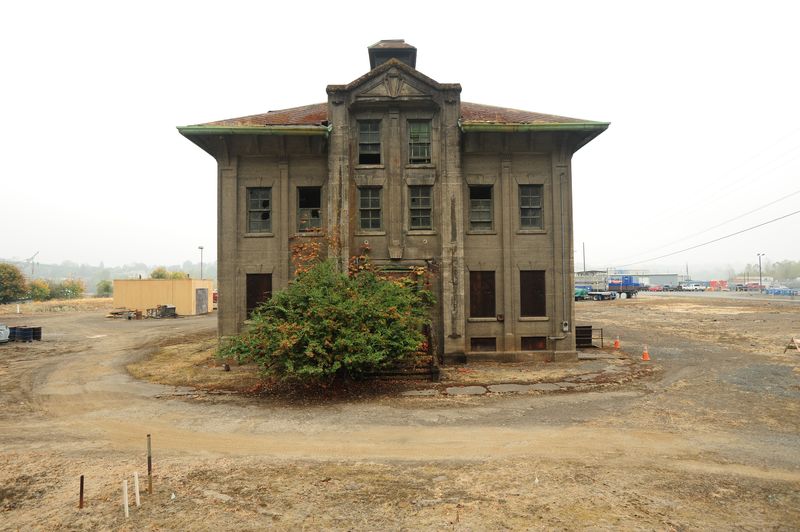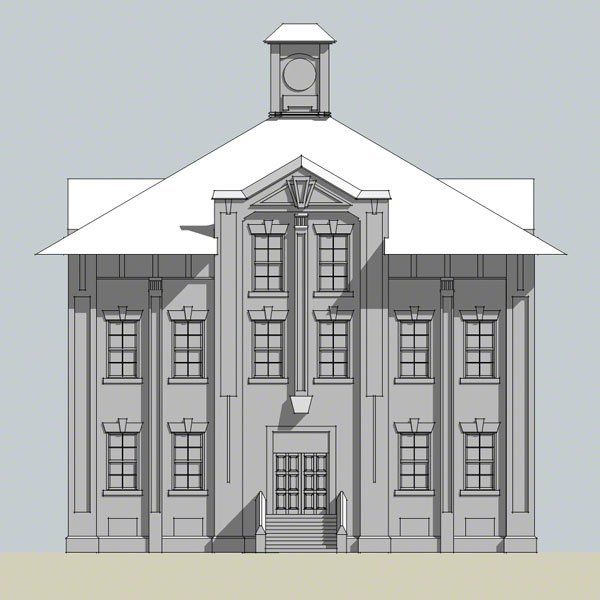In late October, Northwest Natural announced plans to demolish the venerable Gas & Coke Building, a century-old poured-in-place concrete building located just upriver from the St. Johns Bridge at 7900 NW St Helens Road. The 1913 building—a former gas manufacturing plant—has been the subject of ghost stories, speculative histories, and general intrigue since it was vacated in 1957.

A flurry of blogs and stories about the possibility that the building may be demolished in the near future have generated a deluge of online attention over the past week, as well as numerous inquiries to Restore Oregon. According to an October Northwest Examiner interview with Northwest Natural Corporate Communications Manager Melissa Moore, “Unfortunately, because the building has been abandoned for decades and has significant safety issues, we will consider taking it down, possibly in the coming year. The timeline, demolition details or costs have not been determined at this time.”
Unlike many of Portland’s favorite historic buildings, there exists only minimal formal documentation on the history and significance of the Gas & Coke Building. The Examiner offers a few historical tidbits, “It was once the administrative building for the Portland Gas and Coke Company, the forerunner of NW Natural. Nearby were gasification and tar refining plants, whose waste products were discharged into the river and settling ponds. Those wastes included tars, oil, creosote, phenols, poly nuclear automatic hydrocarbons, BTEX and lead.”
The Gas & Coke Building sits within a designated Superfund site that has been described as the second most contaminated property in Portland. Clean-up of Northwest Natural’s contaminated riverfront property will cost at least $43 million. Additionally, the site is extremely vulnerable to a seismic event. According to Restore Oregon Advisor Jay Raskin, “It is an emergency planning nightmare, with toxic materials, liquid fuels, as well as natural gas… Refinery fires are very common with earthquakes and the access to the area is quite restricted, which also makes evacuation difficult.” In addition to concerns about the site, the building, too, would likely need a seismic upgrade if it were to be reused.
Word of demolition has a lot of people asking, can this building be saved? In our work around Oregon, Restore Oregon looks at this question through a couple of lenses.
Designation
In order to be officially “historic,” a building must be designated as such. In Portland, there are several levels of historic designations. Following a 1984 city-wide survey of potentially historic places, the Gas & Coke Building was listed in the Historic Resource Inventory. However, because Oregon law stipulates that owners must consent to historic designation, in 2012 Northwest Natural requested—and was granted approval—for removal of the Gas & Coke Building from the Historic Resource Inventory. Even so, the building meets the criteria for listing on the National Register of Historic Places, according to Jason Allen at the State Historic Preservation Office. Again, to actually be designated on the National Register would require the written support of the owner.
Regulation & Protection
Historic preservation regulations typically exist at the local level. Because the Gas & Coke Building no longer has any formal historic status, the City of Portland’s historic review process does not apply to the property. So Northwest Natural has the right to demolish the building if they choose.
That said, because the property is eligible for listing in the National Register, the Federal Superfund designation may trigger a Section 106 Review. If any Federal funds, licenses, permits, or other activities are connected with the demolition proposal, a consultative mitigation process with the State and other stakeholders is required by Federal Law.

Adaptation
Historic places thrive best when they serve a productive function that is economically viable. As of this writing, Restore Oregon does not have evidence that the building can viably be rehabilitated—nor do we have information that it cannot be rehabilitated. There must exist an economically viable use for a private owner to invest significant rehabilitation dollars into hazardous waste removal, seismic retrofit, and the fire & life safety upgrades that this building would need to be reoccupied. Given its challenging location and Heavy Industrial zoning, reuse of this building will be extraordinary difficult. If, in the future, adaptive reuse of the building aligns with property owner goals and improvements to the site, there are financial incentives available for rehabilitation.
Demolishing the building will be costly—probably in the tens of thousands of dollars range. Because the building has served as a photogenic relic for over 50 years, local advocates might consider advocating for options to seal the building to alleviate Northwest Natural’s understandable concerns about liability. Because the entire site is contaminated and vulnerable to a seismic event, securely mothballing the Gas & Coke Building is one preservation strategy that would keep opportunities open for redevelopment in the future.
Next Steps
Saving the Gas & Coke Building will require a positive community dialogue with Northwest Natural about the options available for studying and preserving the building. A formal Historic Structure Report that delineated the building’s physical condition and outlined recommendations for treatment would provide a better understanding of the building’s reuse potential. Furthermore, a conceptual reuse study that outlined options for adapting the building for new uses (and associated expense/revenue) could help answer questions about viability that today are unanswered.
Restore Oregon is committed to offering pragmatic solutions for Oregon’s historic places and we very much look forward to a positive and informed discussion about the future of the Gas & Coke Building.

